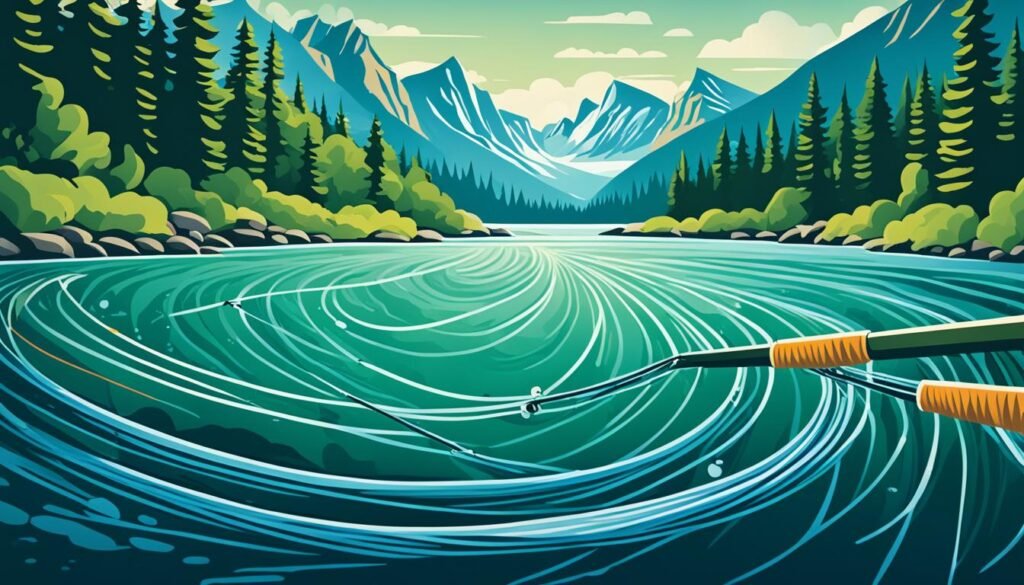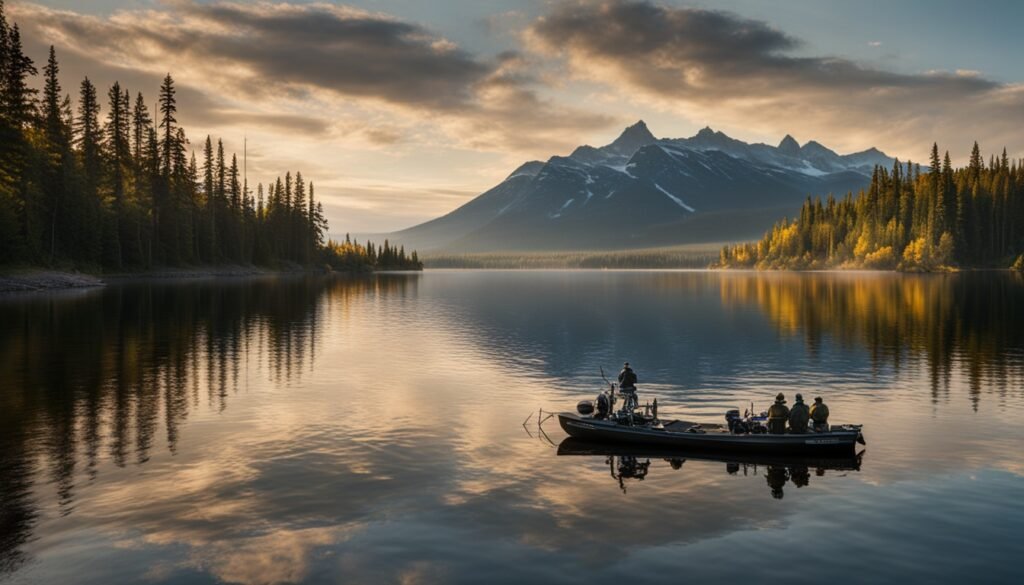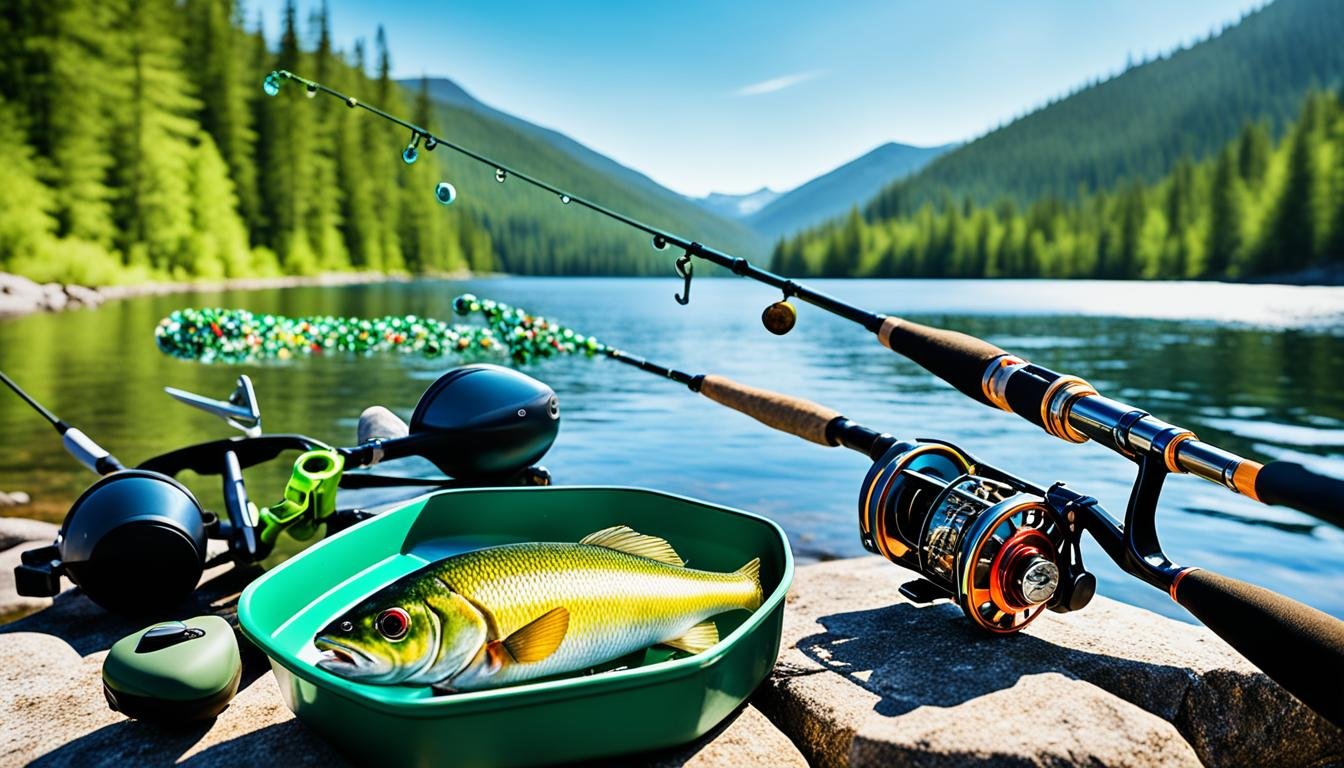Ready to catch the big one in Canada’s waters?
Having the right gear is key for a great fishing trip. Let’s explore what you need to start your angling journey.
This guide will help you choose the best equipment for your fishing adventures. We’ll cover everything from rods to hooks, ensuring you’re well-prepared.
Key Takeaways about Essential Fishing Gear for Beginners
- Beginner-friendly rods typically range from 1.2 to 2 meters (4 to 6 feet) in length
- Spincasting and spinning rods and reels are the two basic setups recommended for beginners
- Monofilament line is the most common fishing line, with strength measured in pounds or kilograms
- Fishing line visibility can be high, low, or invisible, depending on the desired application
- Regulations may require the use of single barbless hooks in certain fishing areas
Essential Fishing Rods and Reels
The right rod and reel combo is key for new anglers. Important factors include rod action, length, and reel type. These elements affect your fishing success and enjoyment.
Choosing the Right Rod
New anglers should start with a medium action rod. It balances sensitivity and strength for handling larger fish. Rod lengths vary from 5.5 to 6 feet.
Longer rods suit open water fishing. Shorter ones work well in areas with low-hanging branches. A 7-foot rod is often ideal for beginners.
- The ideal fishing rod length for beginners is typically around 7 feet.
- Rod power ranges from ultra-light to ultra-heavy, matching the fish size targeted.
- Action on a fishing rod can range from extra fast to slow, affecting sensitivity and casting.
- Rods are rated for certain line sizes and lure weights to optimize performance.
- Most beginners start with fiberglass fishing rods, but others are made from carbon fiber or graphite, which are lighter.
Spinning Reels vs. Baitcasting Reels
Spinning reels attach below the rod and are easier for beginners. They’re affordable and simple to cast. Baitcasting reels mount on top of the rod.
Baitcasting reels need more skill to avoid backlash. They’re better suited for experienced anglers. Spinning reels offer good control and casting distance.
- Spincast reels are simple to use and come at a lower cost than other types of reels.
- Spinning reels offer better control and casting distance than spincast reels.
- Baitcasting reels offer fantastic accuracy and feel but are harder to master than spinning reels.
- Fly fishing reels are specialized for casting ultralight lures and require a different skill set.
For beginners, a 2000, 2500 or 3000 size spinning reel works well. It’s good for trout, walleye, and bass. Pair it with 6 to 8 pounds fishing line for trout and 8 to 12 pounds for walleye.
“Responsible fishing involves adhering to water bodies and fishing quotas to preserve fauna and flora.”
Fishing Line Selection

The right fishing line can greatly impact your angling success. Understanding different line options helps you make better choices and improves your fishing experience.
Quality and type of line are crucial factors. They can significantly affect your catch rate and overall enjoyment on the water.
Monofilament Line
Monofilament is the most common fishing line. It’s usually clear or green, making it versatile for various situations.
This line is user-friendly, affordable, and versatile. Beginners often start with a six-pound monofilament for its balance of strength and sensitivity.
Fluorocarbon Line
Fluorocarbon line is nearly invisible underwater, making it great for line-shy fish like brook trout. It’s more abrasion-resistant and less stretchy than monofilament.
These qualities make fluorocarbon ideal for fishing in complex environments. Many anglers use it as a leader material.
Braided and Fusion Lines
Braided and fusion lines are extremely strong with thin diameters. They work well as main lines in weedy or rocky conditions.
However, these lines are highly visible underwater. Some anglers combine them with fluorocarbon leaders to balance strengths and weaknesses.
When choosing a line, consider line strength, visibility, and diameter. Rod and reel recommendations can guide your selection.
Fishing line strength charts and weight guides are helpful tools. They can assist you in selecting the best line for your target species.
Your fishing line is a crucial part of your gear setup. Understanding different options helps you make informed choices.
With the right line, you can enhance your fishing success. This knowledge leads to more rewarding experiences on the water.
Hooks, Lures, and Bait
Hooks, lures, and bait are crucial for fishing success in Canada. These tools can greatly improve your chances of catching fish. Knowing how to use them effectively is key.
Hooks come in various shapes and sizes for different purposes. Many Canadian waters require single barbless hooks. These are gentler on fish and make release easier.
Bait can be natural, like worms or roe. It can also be artificial, such as scented lures. Common lures include jigs, spoons, and spinners. Choose based on target species and fishing conditions.
Jigs are versatile and great for beginners. They can catch many fish types. Spoons and spinners work well for walleye, pike, and bass.
Spoons flutter during retrieval, attracting fish. Spinners create a spinning motion that triggers predatory instincts. Both are effective for catching specific species.
| Lure Type | Description | Targeted Species |
|---|---|---|
| Jigs | Hooks with a metal weight permanently attached, offering various designs for different fishing techniques and scenarios | Versatile for many fish species |
| Spoons | Metal lures that provide a fluttering action during retrieval | Walleye, pike, bass |
| Spinners | Lures with a spinning metal blade that rotates during retrieval, creating a tantalizing action | Walleye, pike, bass |
Experiment to find the best combination for your local waters. Try different hooks, lures, and bait. This will help you catch more fish in Canadian waters.
“The key to successful fishing is to match your lure or bait to the specific feeding habits and preferences of the fish you’re targeting.”
Essential Fishing Gear for Beginners

Leaders and Swivels
Leaders are vital fishing gear components. They connect the main line to the hook or lure. Leaders should be weaker than the main line to prevent breakage.
Swivels join the main line to the leader. They allow free turning and prevent twisting, especially with active lures.
Weights and Floats
Weights, or sinkers, help cast further and sink bait. They’re made of lead or tungsten. Floats, or bobbers, keep hooks off the bottom.
They let you adjust the depth of your bait or lure. This helps present your offering at the right level.
- Average weight strength for a medium action rod: 8lb to 20lb
- Common line types: braided, fluorocarbon, monofilament
- Recommended monofilament line weight: 10 lb test
- Minimum knots to learn for freshwater fishing: improved clinch, palomar, uni
- Types of tackle for first-time anglers: hooks, weights, floats
- Recommended hook brand: Gamakatsu
- Common bait for most freshwater fish: nightcrawlers
- Recommended hook size for panfish: 8 or 10
- Recommended hook size for predatory fish like bass: size 2 or 4
“Persistence is the key characteristic advised for new anglers by expert Steve Meiser.”
Tackle Boxes and Accessories
A good tackle box can make your fishing trip better. It keeps your tools and gear organized. Essential accessories include pliers, knives, landing nets, and coolers.
Pliers and Knives
Fishing pliers are a must-have for your tackle box. They help remove hooks, crimp split shots, and cut fishing line. A sharp fishing knife is also essential.
Look for a knife with a serrated edge and secure grip. It will help with various tasks, from cutting bait to filleting fish.
Landing Nets and Coolers
Landing nets help you safely scoop up your catch. Choose a net with a sturdy frame and deep, fine-mesh bag. This ensures a secure and careful release.
A reliable fishing cooler keeps your catches fresh. Get a well-insulated cooler that can handle a day on the water. It will maintain the right temperature to preserve your fish.
The right tackle box and accessories prepare you for any fishing challenge. These tools help you handle your catch with care and skill. They ensure a fun and successful fishing trip.
| Accessory | Purpose | Key Features |
|---|---|---|
| Fishing Pliers | Removing hooks, crimping split shots, cutting line | Durable, versatile, secure grip |
| Fishing Knife | Cleaning and preparing catches | Serrated edge, secure grip |
| Landing Net | Safely scooping up catches | Sturdy, lightweight frame, deep fine-mesh bag |
| Fishing Cooler | Keeping catches fresh | Well-insulated, durable construction |
“A well-stocked tackle box is the key to a successful and enjoyable fishing trip. Having the right accessories on hand can make all the difference in your ability to handle your catch with care and efficiency.”
Conclusion
The right fishing gear is crucial for a successful angling experience in Canada. Abu Garcia and Lew’s offer popular medium-weight setups. These versatile options suit various fishing situations.
Don’t forget to get your fishing licence and know local regulations. Invest in polarized sunglasses, sun-protective hats, and reliable tools like needle-nose pliers. These essentials will help you start your fishing journey confidently.
With proper equipment and knowledge, you’ll be ready to target trout, catfish, or bass. Research and invest in appropriate gear to make the most of your time on the water.
Remember, the right gear can transform your fishing experience. By following these tips, you’ll be well-equipped to enjoy Canada’s great outdoors. Happy fishing!
For an overview about Fishing for Beginners in Canada, please check this guide.
FAQ about Essential Fishing Gear for Beginners
What fishing gear do I need for beginners?
For beginners, the essential fishing gear includes:
- Fishing rod and reel combo (preferably a spinning rod and reel for ease of use)
- Fishing line (often pre-spooled on beginner combos)
- Hooks
- Bait (live bait like worms or artificial lures)
- Bobbers
- Sinkers
- Tackle box
- Pliers and line cutter
- Fishing license
What to get a beginner fisherman?
A good starter kit for a beginner fisherman should include:
- A spinning rod and reel combo
- A variety of hooks and lures
- A basic tackle box
- Bobbers and sinkers
- A pair of needle-nose pliers
- Sunscreen and a hat for sun protection
- A beginner’s guide to fishing or local fishing regulations
What is the simplest fishing gear?
The simplest fishing gear setup for beginners is:
- A basic spinning rod and reel combo
- Monofilament fishing line
- Simple J-hooks
- Live bait (like worms)
- Bobbers
- Sinkers
This setup allows for easy casting and is suitable for catching a variety of fish species in both freshwater and shallow saltwater environments.
What type of fishing is best for beginners?
The best types of fishing for beginners are:
- Float (bobber) fishing – It’s visual and helps teach when to set the hook
- Spin casting – Easy to use and great for catching panfish
- Shore fishing in lakes or rivers – Accessible and doesn’t require a boat
- Fishing for panfish like sunfish or perch – These fish are abundant and easier to catch
Starting with these methods in calm, accessible waters like ponds, lakes, or slow-moving rivers is ideal for beginners to build their skills and confidence.
What are the essential fishing gear items for beginners?
Beginners need a fishing rod, reel, line, and hooks. They also require lures, bait, a tackle box, and various accessories. Pliers, nets, and coolers are useful add-ons for new anglers.
How do I choose the right fishing rod?
Consider the rod’s action, length, and reel type when choosing. Medium action rods offer a good balance for beginners. They provide sensitivity and strength for handling larger fish.
Rod lengths typically range from 5.5 to 6 feet. Longer rods suit open water fishing. Shorter rods work well in areas with low-hanging branches.
What are the differences between spinning reels and baitcasting reels?
Spinning reels attach below the rod and are easier for beginners. Baitcasting reels mount on top and require more skill. They’re better suited for experienced anglers.
What types of fishing line should I use?
The main fishing line types are monofilament, fluorocarbon, and braided/fusion. Monofilament is versatile and great for all-purpose use. Fluorocarbon is nearly invisible underwater, making it ideal for leaders.
Braided and fusion lines are strong and thin. However, they’re highly visible, so they’re best used as main lines.
What kinds of hooks, lures, and bait should I use?
Hooks come in various shapes and sizes for different purposes. Bait can be natural, like worms, or artificial, such as scented lures. Common lures include jigs, spoons, and spinners.
Choose hooks, lures, and bait based on your target fish species and fishing conditions.
What other essential gear do I need for fishing?
Essential gear includes leaders and swivels to connect your line to hooks or lures. Weights and floats help adjust depth and casting distance. A tackle box keeps everything organized.
Accessories like pliers, knives, and landing nets are also important. Don’t forget a cooler to store your catch!
Source Links
- https://www.gofishbc.com/learn/fishing-tips/lake-fishing/beginners-guide-to-fishing-rods-tackle/
- https://cottagelife.com/outdoors/fishing-101-a-guide-for-beginners/
- https://midwestoutdoors.com/fishing/canadian-fishing-trip-preparation-tackle-and-gear-for-your-fishing-vacation/
- https://www.sail.ca/blog/what-to-put-in-your-first-fishing-kit-the-essentials-for-beginners/
- https://fishingbooker.com/blog/fishing-gear-for-beginners/
- https://www.coastalfishing.com/blogs/saltwater-fishing-101/best-saltwater-fishing-gear-and-equipment-for-beginners
- https://www.takemefishing.org/how-to-fish/fishing-gear-and-tackle/how-to-choose-fishing-line/
- https://gofishbc.com/learn/fishing-tips/lake-fishing/beginners-guide-to-fishing-rods-tackle/
- https://reddit.com/r/FishingForBeginners/comments/h16jfa/beginner_starting_gear_fishing_line/
- https://fishbrain.com/blog/fishing-gear/fishing-starter-kit-essential-gear-for-beginners
- https://www.triggersandbows.com/2020/06/25/a-beginners-guide-to-fishing-gear/
- https://shopkarls.com/c/fishing-101/essential-gear-the-guide-to-bait-and-tackle
- https://deepersonar.com/blogs/us/top-7-fishing-gear-essentials-first-time-anglers
- https://www.orvis.com/fly-fishing/featured/fly-fishing-gear-for-beginners
- https://www.leatherman.com/blog/10-things-you-need-in-your-fishing-tackle-box.html
- https://www.mossyoak.com/our-obsession/blogs/fishing/what-should-be-in-your-tackle-box-8-tips-for-newbies
- https://www.canadiantire.ca/en/cat/toys-sports-recreation/fishing-DC0002124.html
- https://www.atlantisshowroom.com/blogs/news/essential-fishing-gear-for-beginners-a-comprehensive-guide
- https://geartopdesign.com/blogs/news/beginner-fishing-tips-10-essential-gear-items-for-every-trip
- https://villafirenzecr.com/equipment-essentials-for-sportfishing-in-costa-rica/


